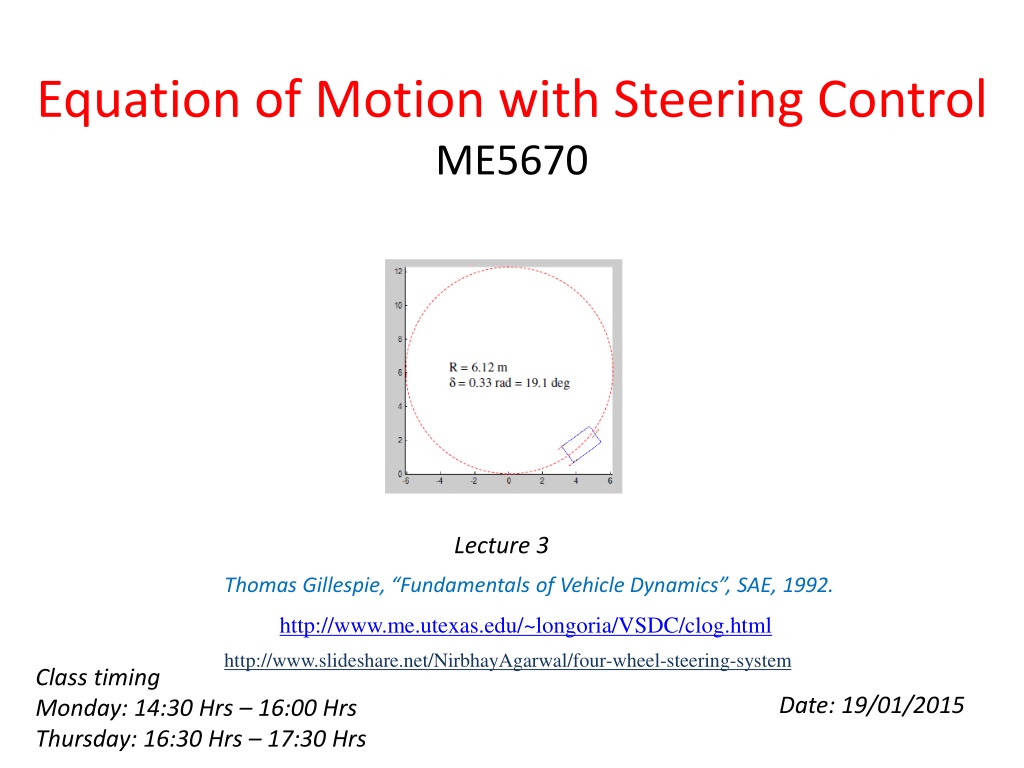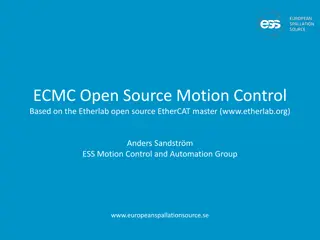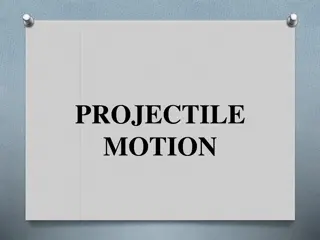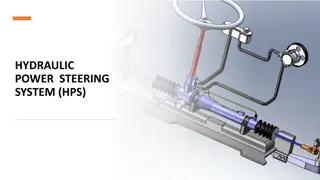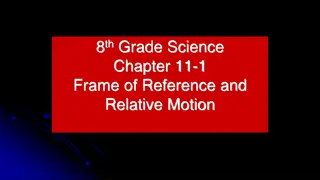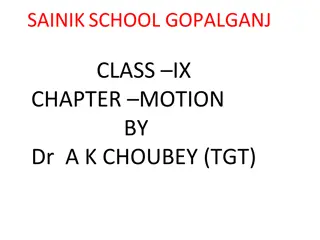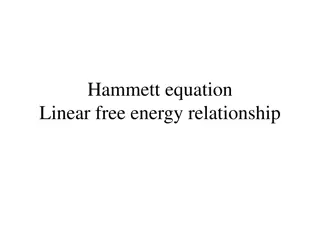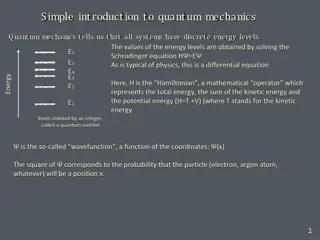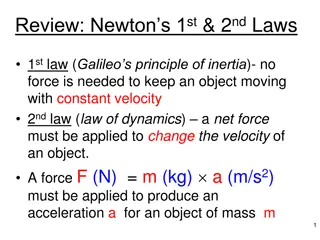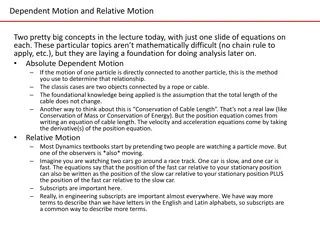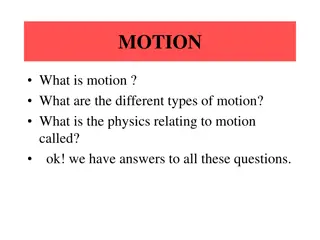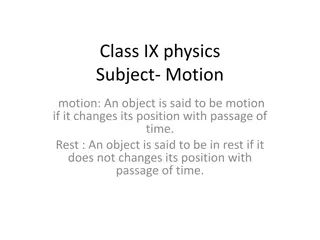Equation of Motion with Steering Control
Differential steering of a single-axle vehicle in planar turning motion. Velocities in a body-fixed frame, including wheel angular velocities and yaw rate. Position and velocity relationships in the global reference frame. MATLAB programming for a differentially-driven single-axle vehicle with the center of gravity on the axle.
Download Presentation

Please find below an Image/Link to download the presentation.
The content on the website is provided AS IS for your information and personal use only. It may not be sold, licensed, or shared on other websites without obtaining consent from the author.If you encounter any issues during the download, it is possible that the publisher has removed the file from their server.
You are allowed to download the files provided on this website for personal or commercial use, subject to the condition that they are used lawfully. All files are the property of their respective owners.
The content on the website is provided AS IS for your information and personal use only. It may not be sold, licensed, or shared on other websites without obtaining consent from the author.
E N D
Presentation Transcript
Equation of Motion with Steering Control ME5670 Lecture 3 Thomas Gillespie, Fundamentals of Vehicle Dynamics , SAE, 1992. http://www.me.utexas.edu/~longoria/VSDC/clog.html http://www.slideshare.net/NirbhayAgarwal/four-wheel-steering-system Class timing Monday: 14:30 Hrs 16:00 Hrs Thursday: 16:30 Hrs 17:30 Hrs Date: 19/01/2015
Kinematic Models of 2D Steering Turning Example: Differential steering of a single-axle vehicle in planar, turning motion For the simple vehicle model shown to the left, there are negligible forces at point A. This could be a pivot, caster, or some other omni-directional type wheel. Assume the vehicle has constant forward velocity, U. Assume the wheels roll without slip and cannot slip laterally. Designate the right wheel 1 and the left 2 . What are the velocities in a body-fixed frame? Also find the yaw angular rate.
Solution 1. Apply 2. Velocity at the left wheel Applying the lateral constraint ?2?= 0 2. Velocity at the right wheel 3. Velocity of CG: where, ?1 and ?2 are wheel angular velocity and ?? is the wheel radius 5. Yaw rate:
Kinematics: Example 2 Position and velocity in inertial frame Vehicle kinematic state in the inertial frame . Velocities in the local reference frame are related with the inertial frame by the rotation matrix . Velocities in the global reference frame From Example 1, we have Velocities in the global reference frame in terms of wheel velocities are
Kinematics: Example 3 Differentially-driven single axle vehicle with CG on axle For a kinematic model for a vehicle with CG on axle and Velocities in the global reference frame MATLAB programming clear all global R_w B omegaw1 omegaw2 R_w = 0.05; B = 0.18; omegaw1 = 4; omegaw2 = 2; Xi0=[0,0,0]; [t,Xi] = ode45(@DS_vehicle,[0 10],Xi0); N = length(t); figure(1) plot(Xi(:,1),Xi(:,2)), axis([-1.0 1.0 -0.5 1.5]), axis('square') xlabel('X'), ylabel('Y') function Xidot = DS_vehicle(t,Xi) global R_w B omegaw1 omegaw2 X = Xi(1); Y = Xi(2); psi = Xi(3); Xdot = 0.5*cos(psi)*R_w*(omegaw1+omegaw2); Ydot = 0.5*sin(psi)*R_w*(omegaw1+omegaw2); psidot = R_w*(omegaw1-omegaw2)/B; Xidot=[Xdot;Ydot;psidot]; Courtesy: Prof. R.G. Longoria
Kinematics: 2D Animation Differentially-driven single axle vehicle with CG on axle Vehicle State function [xb, yb, xfc, yfc, xrlw, yrlw, xrrw, yrrw] = vehicle_state(q,u) global L B R_w % x and y are the coordinates at the rear axle center - CG location % u is a control input x = q(1); y = q(2); psi = q(3); % xfc and yfc are coordinates of a center pivot at front % then the pivot point is located w.r.t CG at a distance L % Find coordinates to draw wheels % rear left wheel xrlwf = xrl + R_w*cos(psi); yrlwf = yrl + R_w*sin(psi); xrlwr = xrl - R_w*cos(psi); yrlwr = yrl - R_w*sin(psi); % rear right wheel xrrwf = xrr + R_w*cos(psi); yrrwf = yrr + R_w*sin(psi); xrrwr = xrr - R_w*cos(psi); yrrwr = yrr - R_w*sin(psi); xrlw = [xrlwf, xrlwr]; yrlw = [yrlwf, yrlwr]; xrrw = [xrrwf, xrrwr]; yrrw = [yrrwf, yrrwr]; xfc = x + 1*L*cos(psi); yfc = y + 1*L*sin(psi); % Find coordinates of vehicle base xfl = xfc - 0.5*B*sin(psi); yfl = yfc + 0.5*B*cos(psi); xfr = xfc + 0.5*B*sin(psi); yfr = yfc - 0.5*B*cos(psi); xrl = x - 0.5*B*sin(psi); yrl = y + 0.5*B*cos(psi); xrr = x + 0.5*B*sin(psi); yrr = y - 0.5*B*cos(psi); xb = [xfl, xfr, xrr, xrl, xfl]; % x coordinates for vehicle base yb = [yfl, yfr, yrr, yrl, yfl]; % y coordinates for vehicle base Courtesy: Prof. R.G. Longoria
Kinematics: 2D Animation Differentially-driven single axle vehicle with CG on axle Rk4 Solver function [T,X]=rk4fixed(Fcn,Tspan,X0,N) h = (Tspan(2)-Tspan(1))/N; halfh = 0.5*h; neqs=size(X0); X=zeros(neqs(1),N); T=zeros(1,N); X(:,1)=X0; T(1)=Tspan(1); Td = Tspan(1); Xd = X0; for i=2:N, RK1 = feval(Fcn,Td,Xd); Thalf = Td + halfh; Xtemp = Xd + halfh*RK1; RK2 = feval(Fcn,Thalf,Xtemp); Xtemp = Xd + halfh*RK2; RK3 = feval(Fcn,Thalf,Xtemp); Tfull = Td + h; Xtemp = Xd + h*RK3; RK4 = feval(Fcn,Tfull,Xtemp); X(:,i) = Xd + h*(RK1+2.0*(RK2+RK3)+RK4)/6; T(i) = Tfull; Xd = X(:,i); Td = T(i); end X=X';T=T'; Courtesy: Prof. R.G. Longoria
2D Animation Sim_2Danim.m % Vehicle_State provides spatial state information for the vehicle clear all; % Clear all variables close all; % Close all figures global L B R_w omegaw1 omegaw2 % Geometric vehicle parameters L = 0.20; % wheel base B = 0.18; % rear axle track width R_w = 0.05; % wheel radius % Initial location and orientation of the vehicle CG x0 = 0; y0 = 0; psi0 = 0*pi/180; % psi = yaw angle in radians fig1 = figure(1); axis([-1.0 1.0 -0.5 1.5]); axis('square') xlabel('X'), ylabel('Y') hold on; q0=[x0,y0,psi0]; [xb, yb, xfc, yfc, xrlw, yrlw, xrrw, yrrw] = vehicle_state(q0,0); % Plot vehicle and define component plots plotzb = plot(xb, yb); % Plot robot base plotzfc = plot(xfc, yfc, 'o'); % Plot front pivot plotzrlw = plot(xrlw, yrlw, 'r'); % Plot rear left wheel plotzrrw = plot(xrrw, yrrw, 'r'); % Plot rear right wheel % Set handle graphics parameters and plotting modes set(gca, 'drawmode','fast'); set(plotzb, 'erasemode', 'xor'); % use 'xor' rather than 'none' to redraw set(plotzfc, 'erasemode', 'xor'); set(plotzrlw, 'erasemode', 'xor'); set(plotzrrw, 'erasemode', 'xor'); q1 = q0; % Set initial state to q1 for simulation % Fixed wheel speed command - should make a circle! omegaw1 = 2; omegaw2 = 1; Courtesy: Prof. R.G. Longoria
Kinematics: 2D Animation % Parameters related to simulations tfinal = 100; N = 30; % Number of iterations dt = tfinal/N; % Time step interval t = [0:dt:tfinal]; % Beginning of simulation and animation for i = 1:N+1 to = t(i); tf = t(i)+dt; % integrate from to to tf [t2,q2]=rk4fixed('dssakv',[to tf],q1',2); t1 = t2(2); % keep only the last point q1 = q2(2,:); % store q2 in q1 for next step % capture the state of the vehicle for animation [xb, yb, xfc, yfc, xrlw, yrlw, xrrw, yrrw] = vehicle_state(q1, 0); plot(xfc,yfc,'r.') % Plot vehicle - updates data in each plot set(plotzb,'xdata',xb); set(plotzb,'ydata',yb); set(plotzfc,'xdata',xfc); set(plotzfc,'ydata',yfc); set(plotzrlw,'xdata',xrlw); set(plotzrlw,'ydata',yrlw); set(plotzrrw,'xdata',xrrw); set(plotzrrw,'ydata',yrrw); pause(0.2); % Pause by X seconds for slower animation end Courtesy: Prof. R.G. Longoria
Ackerman Steering : A Tricycle Single-axle vehicle with front-steered wheel; rolling rear wheels For a given steer angle ? and C.G. velocity along x as v. Velocities in the inertial frame is given by The input control variables are ? = ??? and steer angle ? Here, C.G. is located at the rear axle, its velocity is given by ? =1 2?1+ ?2, where ?1= ???1 and ?2= ???2 Forward velocty at the front wheel is ? along x. ? . Because of steering, the velocity along the path of the wheel is ??= The velocity lateral to the wheel is ??= ??sin ? = ? tan(?) ??? cos(?) ? =? ??? Therefore, ??= ?tan ? = tan ? = Courtesy: Prof. R.G. Longoria
Kinematics: 2D Animation Differentially-driven single axle tricycle % Find coordinates to draw wheels % rear left wheel xrlwf = xrl + R_w*cos(psi); yrlwf = yrl + R_w*sin(psi); xrlwr = xrl - R_w*cos(psi); yrlwr = yrl - R_w*sin(psi); % rear right wheel xrrwf = xrr + R_w*cos(psi); yrrwf = yrr + R_w*sin(psi); xrrwr = xrr - R_w*cos(psi); yrrwr = yrr - R_w*sin(psi); % define the states % front center point (not returned) qfc = [xfc, yfc]; % body x-y points xb = [xfl, xfr, xrr, xrl, xfl]; yb = [yfl, yfr, yrr, yrl, yfl]; % front wheel x-y points xfw = [xfwf, xfwr]; yfw = [yfwf, yfwr]; % rear-left wheel x-y points xrlw = [xrlwf, xrlwr]; yrlw = [yrlwf, yrlwr]; % rear-right wheel x-y points xrrw = [xrrwf, xrrwr]; yrrw = [yrrwf, yrrwr]; Tricycle State function [xb, yb, xfw, yfw, xrlw, yrlw, xrrw, yrrw] = tricycle_state(q, u) global L B R_w % x and y are the coordinates at the rear axle center - CG location % u is a control input x = q(1); y = q(2); psi = q(3); v = u(1); delta = u(2); % xfc and yfc are coordinates of a center pivot at front % then the pivot point is located w.r.t CG at a distance L xfc = x + L*cos(psi); yfc = y + L*sin(psi); % Find coordinates of vehicle base xfl = xfc - 0.5*B*sin(psi); yfl = yfc + 0.5*B*cos(psi); xfr = xfc + 0.5*B*sin(psi); yfr = yfc - 0.5*B*cos(psi); xrl = x - 0.5*B*sin(psi); yrl = y + 0.5*B*cos(psi); xrr = x + 0.5*B*sin(psi); yrr = y - 0.5*B*cos(psi); % end points of the front-steered wheel xfwf = xfc + R_w*cos(psi+delta); yfwf = yfc + R_w*sin(psi+delta); xfwr = xfc - R_w*cos(psi+delta); yfwr = yfc - R_w*sin(psi+delta); Courtesy: Prof. R.G. Longoria
2D Animation % sim_tricycle_model.m clear all; % Clear all variables close all; % Close all figures global L B R_w vc delta_radc function qdot = ks_tricycle_kv(t,q) global L vc delta_radc delta_max_deg R_w % Physical parameters of the tricycle L = 2.040; %0.25; % [m] B = 1.164; %0.18; % Distance between the rear wheels [m] m_max_rpm = 8000; % Motor max speed [rpm] gratio = 20; % Gear ratio R_w = 13/39.37; % Radius of wheel [m] % L is length between the front wheel axis and rear wheel %axis [m] % vc is speed command % delta_radc is the steering angle command % State variables x = q(1); y = q(2); psi = q(3); % Control variables v = vc; delta = delta_radc; % kinematic model xdot = v*cos(psi); ydot = v*sin(psi); psidot = v*tan(delta)/L; qdot = [xdot;ydot;psidot]; % Parameters related to vehicle m_max_rads = m_max_rpm*2*pi/60; % Motor max speed [rad/s] w_max_rads = m_max_rads/gratio; % Wheel max speed [rad/s] v_max = w_max_rads*R_w; % Max robot speed [m/s] % Initial values x0 = 0; % Initial x coodinate [m] y0 = 0; % Initial y coodinate [m] psi_deg0 = 0; % Initial orientation of the robot (theta [deg]) % desired turn radius R_turn = 3*L; delta_max_rad = L/R_turn; % Maximum steering angle [deg] % Parameters related to simulations t_max = 10; % Simulation time [s] n = 100; % Number of iterations dt = t_max/n; % Time step interval t = [0:dt:t_max]; % Time vector (n+1 components) Courtesy: Prof. R.G. Longoria
2D Animation % velocity and steering commands (open loop) v = v_max*ones(1,n+1); % Velocity vector (n+1 components) delta_rad = delta_max_rad*ones(1,n+1); % Steering angle vector (n+1 %components) [rad] psi_rad0 = psi_deg0*pi/180; % Initial orientation [rad] v0 = v(1); % Initial velocity [m/s] delta_rad0 = delta_rad(1); % Initial steering angle [rad] q0 = [x0, y0, psi_rad0]; % Initial state vector u0 = [v0, delta_rad0]; % Initial control vector fig1 = figure(1); % Figure set-up (fig1) axis([-R_turn R_turn -0*R_turn 2*R_turn]); axis('square') hold on; % Acquire the configuration of robot for plot [xb, yb, xfw, yfw, xrlw, yrlw, xrrw, yrrw] = tricycle_state(q0, u0); plotqb = plot(xb, yb); % Plot vehicle base plotqfw = plot(xfw, yfw, 'r'); % Plot front wheel plotqrlw = plot(xrlw, yrlw, 'r'); % Plot rear left wheel plotqrrw = plot(xrrw, yrrw, 'r'); % Plot rear right wheel % Draw fast and erase fast set(gca, 'drawmode','fast'); set(plotqb, 'erasemode', 'xor'); set(plotqfw, 'erasemode', 'xor'); set(plotqrlw, 'erasemode', 'xor'); set(plotqrrw, 'erasemode', 'xor'); % Beginning of simulation for i = 1:n+1 v(i) = v_max*cos(2*delta_rad(i)); u = [v(i), delta_rad(i)]; % Set control input vc = u(1); delta_radc = u(2); to = t(i); tf = t(i)+dt; [t2,q2]=rk4fixed('ks_tricycle_kv',[to tf],q1',2); t1 = t2(2); q1 = q2(2,:); % Acquire the configuration of vehicle for plot [xb, yb, xfw, yfw, xrlw, yrlw, xrrw, yrrw] = tricycle_state(q1, u); % Plot vehicle set(plotqb,'xdata',xb); set(plotqb,'ydata',yb); set(plotqfw,'xdata',xfw); set(plotqfw,'ydata',yfw); set(plotqrlw,'xdata',xrlw); set(plotqrlw,'ydata',yrlw); set(plotqrrw,'xdata',xrrw); set(plotqrrw,'ydata',yrrw); % drawnow pause(0.1); % Pause by 0.2s for slower simulation end q1 = q0; % Set initial state to z1 for simulation Courtesy: Prof. R.G. Longoria
2D Animation % Plot the resultant velocity and steering angle configurations fig2 = figure(2); % Figure set-up (fig2) subplot(2,1,1); % Upper half of fig1 plot(t, v); % Plot velocity-time curve xlabel('Time [s]'); ylabel('Velocity [m/s]'); subplot(2,1,2); % Lower half of fig1 deltad = delta_rad*180/pi; % Steering angle vector (n+1 comp.) [deg] plot(t,deltad); % Plot steering angle-time curve xlabel('Time [s]'); ylabel('Steering angle [deg]'); 12 Velocity [m/s] 11 10 9 0 1 2 3 4 5 6 7 8 9 10 Time [s] 21 Steering angle [deg] 20 19 18 0 1 2 3 4 5 6 7 8 9 10 Time [s] Courtesy: Prof. R.G. Longoria
Kinematics: Lane Change Problem Differentially-driven Double axle Four Wheel Vehicle Four Wheel Vehicle State % end points of the front-steered wheel xfwfr = xfl + R_w*cos(psi+delta); yfwfr = yfl + R_w*sin(psi+delta); xfwrr = xfl - R_w*cos(psi+delta); yfwrr = yfl - R_w*sin(psi+delta); function [xb, yb, xfc, yfc, xfwr, yfwr,xfwl, yfwl, xrlw, yrlw, xrrw, yrrw] = Fourwheel_state(q, u) global L B R_w % end points of the front-steered wheel xfwfl = xfr + R_w*cos(psi+delta); yfwfl = yfr + R_w*sin(psi+delta); xfwrl = xfr - R_w*cos(psi+delta); yfwrl = yfr - R_w*sin(psi+delta); x = q(1); y = q(2); psi = q(3); v = u(1); delta = u(2); % locates front-center point xfc = x + L*cos(psi); yfc = y + L*sin(psi); % end points of the rear-left wheel xrlwf = xrl + R_w*cos(psi); yrlwf = yrl + R_w*sin(psi); xrlwr = xrl - R_w*cos(psi); yrlwr = yrl - R_w*sin(psi); % locates four corners xfl = xfc - 0.5*B*sin(psi); yfl = yfc + 0.5*B*cos(psi); xfr = xfc + 0.5*B*sin(psi); yfr = yfc - 0.5*B*cos(psi); xrl = x - 0.5*B*sin(psi); yrl = y + 0.5*B*cos(psi); xrr = x + 0.5*B*sin(psi); yrr = y - 0.5*B*cos(psi); % end points of the rear-right wheel xrrwf = xrr + R_w*cos(psi); yrrwf = yrr + R_w*sin(psi); xrrwr = xrr - R_w*cos(psi); yrrwr = yrr - R_w*sin(psi); ];
2D Animation % sim_tricycle_model.m clear all; % Clear all variables close all; % Close all figures global L B R_w vc delta_radc % define the states % front center point (not returned) qfc = [xfc, yfc]; % Physical parameters of the tricycle L = 2.040; %0.25; % [m] B = 1.164; %0.18; % Distance between the rear wheels [m] m_max_rpm = 8000; % Motor max speed [rpm] gratio = 20; % Gear ratio R_w = 13/39.37; % Radius of wheel [m] % body x-y points xb = [xfl, xfr, xrr, xrl, xfl]; yb = [yfl, yfr, yrr, yrl, yfl]; % Parameters related to vehicle m_max_rads = m_max_rpm*2*pi/60; % Motor max speed [rad/s] w_max_rads = m_max_rads/gratio; % Wheel max speed [rad/s] v_max = w_max_rads*R_w; % Max robot speed [m/s] % left front wheel x-y points xfwl = [xfwfl, xfwrl]; yfwl = [yfwfl, yfwrl]; % Right front wheel x-y points xfwr = [xfwfr, xfwrr]; yfwr = [yfwfr, yfwrr]; % Initial values x0 = 0; % Initial x coodinate [m] y0 = 0; % Initial y coodinate [m] psi_deg0 = 0; % Initial orientation of the robot (theta [deg]) % rear-left wheel x-y points xrlw = [xrlwf, xrlwr]; yrlw = [yrlwf, yrlwr]; % desired turn radius R_turn = 3*L; delta_max_rad = L/R_turn; % Maximum steering angle [deg] % Parameters related to simulations t_max = 10; % Simulation time [s] n = 100; % Number of iterations dt = t_max/n; % Time step interval t = [0:dt:t_max]; % Time vector (n+1 components) % rear-right wheel x-y points xrrw = [xrrwf, xrrwr]; yrrw = [yrrwf, yrrwr];
2D Animation % velocity and steering commands (open loop) v = v_max*ones(1,n+1); % Velocity vector (n+1 components) delta_rad = delta_max_rad*ones(1,n+1); % Steering angle vector (n+1 %components) [rad] psi_rad0 = psi_deg0*pi/180; % Initial orientation [rad] v0 = v(1); % Initial velocity [m/s] delta_rad0 = delta_rad(1); % Initial steering angle [rad] q0 = [x0, y0, psi_rad0]; % Initial state vector u0 = [v0, delta_rad0]; % Initial control vector fig1 = figure(1); % Figure set-up (fig1) axis([-R_turn R_turn -0*R_turn 2*R_turn]); axis('square') hold on; % Acquire the configuration of robot for plot [xb, yb, xfw, yfw, xrlw, yrlw, xrrw, yrrw] = tricycle_state(q0, u0); plotqb = plot(xb, yb); % Plot vehicle base plotqfw = plot(xfw, yfw, 'r'); % Plot front wheel plotqrlw = plot(xrlw, yrlw, 'r'); % Plot rear left wheel plotqrrw = plot(xrrw, yrrw, 'r'); % Plot rear right wheel % Draw fast and erase fast set(gca, 'drawmode','fast'); set(plotqb, 'erasemode', 'xor'); set(plotqfw, 'erasemode', 'xor'); set(plotqrlw, 'erasemode', 'xor'); set(plotqrrw, 'erasemode', 'xor'); % Beginning of simulation for i = 1:n+1 v(i) = v_max*cos(2*delta_rad(i)); u = [v(i), delta_rad(i)]; % Set control input vc = u(1); delta_radc = u(2); to = t(i); tf = t(i)+dt; [t2,q2]=rk4fixed('ks_tricycle_kv',[to tf],q1',2); t1 = t2(2); q1 = q2(2,:); % Acquire the configuration of vehicle for plot [xb, yb, xfw, yfw, xrlw, yrlw, xrrw, yrrw] = tricycle_state(q1, u); % Plot vehicle set(plotqb,'xdata',xb); set(plotqb,'ydata',yb); set(plotqfw,'xdata',xfw); set(plotqfw,'ydata',yfw); set(plotqrlw,'xdata',xrlw); set(plotqrlw,'ydata',yrlw); set(plotqrrw,'xdata',xrrw); set(plotqrrw,'ydata',yrrw); % drawnow pause(0.1); % Pause by 0.2s for slower simulation end q1 = q0; % Set initial state to z1 for simulation
Practice Problem A Great Acknowledgement to Prof. R.G. Longoria of Texas University!
